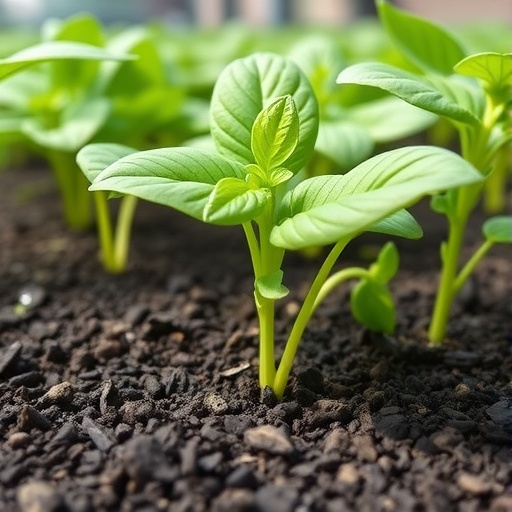In a groundbreaking study emerging from Deakin University’s Centre for Sustainable Bioproducts, researchers have demonstrated the remarkable potential of biochar to revolutionize basil cultivation through the integration of smart-monitoring technologies. This innovative approach combines the ancient practice of soil amendment with cutting-edge Internet of Things (IoT) systems to create a data-driven, sustainable horticultural model that could redefine urban agriculture and plant growth efficiency worldwide.
The research, recently published in the journal Biochar, presents an experimental investigation into the effects of biochar-enhanced potting media on Ocimum basilicum, commonly known as basil. Utilizing smart growth cabinets equipped with high-resolution cameras and a battery of environmental sensors, the study monitored basil plants under controlled conditions over a 30-day growth period. This setup allowed real-time tracking of crucial growth parameters such as leaf area expansion, root development, ambient humidity, and light intensity, providing a granular understanding of plant responses to various substrates.
Central to the study were six distinct growth media formulations, meticulously designed to juxtapose traditional soil-based mediums against advanced soilless counterparts incorporating sand, coconut coir, and perlite. Among these, biochar—a highly porous carbonaceous material derived from the pyrolysis of organic waste—was evaluated both in untreated form and enriched with nutrients to ascertain its dual role as a soil conditioner and slow-release fertilizer. The physical and chemical properties of biochar, such as high cation exchange capacity and superior water retention, underpinned hypotheses about its potential to enhance nutrient availability and root aeration for potted herbs.
The empirical results were compelling. Substituting 10 to 20 percent of conventional potting mix with nutrient-enriched biochar not only bolstered root mass and leaf development but also resulted in an approximate threefold increase in biomass accumulation compared to media containing untreated biochar. This underscores the significance of biochar’s nutrient profile and its capacity to serve as a matrix for controlled nutrient release, thereby reducing the dependency on synthetic fertilizers that often contribute to environmental degradation and greenhouse gas emissions.
Intriguingly, the study found that biochar’s benefits are highly contingent on both its application rate and treatment status. Excessive biochar incorporation or the use of untreated biochar blends with sand and coir exhibited inhibitory effects on basil growth, emphasizing the necessity for optimizing biochar formulations tailored to specific crop requirements. These findings highlight a precision agriculture perspective, where biochar application rates and compositions are fine-tuned to maximize plant productivity while mitigating potential growth stressors.
The deployment of IoT-driven smart growth cabinets played an instrumental role in elucidating these nuanced responses. The continuous monitoring of microenvironmental variables enabled a detailed temporal correlation between plant physiological status and substrate characteristics. Such real-time data acquisition promises to advance predictive models of plant growth dynamics and nutrient uptake, fostering an era where digital agriculture can finesse material inputs for sustainable food production with unmatched accuracy.
Beyond the immediate agronomic improvements, the implications of integrating biochar into potting mixes extend to climate change mitigation and the circular economy. Biochar’s ability to sequester stable carbon compounds for decades or even centuries in soil matrices positions it as a potent tool for carbon dioxide drawdown. Furthermore, its production valorizes agricultural and forestry residues, transforming biomass waste streams into valuable horticultural amendments, thus closing the loop in organic waste management and promoting resource efficiency.
The researchers advocate for further longitudinal studies to investigate biochar’s long-term nutrient release patterns and interaction with microbial communities in soilless systems. Understanding these dynamics is crucial for scaling biochar applications to commercial horticulture, potentially replacing conventionally applied substrates like perlite, which have notable environmental footprints due to mining and non-renewable extraction methods.
Moreover, the team envisions that the amalgamation of biochar amendment with smart sensing technologies could serve as a blueprint for sustainable intensive agriculture beyond basil, adaptable to various herbs, vegetables, and ornamental plants. Such integration aligns with global efforts to develop resilient food systems in the face of soil degradation, water scarcity, and climate unpredictability, underscoring the transformative potential of combining traditional soil science with modern digital innovation.
Lead author Sirjana Adhikari emphasizes the dual advantage of this approach: “Biochar-enhanced growth media not only drive superior plant performance but also contribute significantly to carbon sequestration strategies. The synergy between biochar’s physical properties and IoT-enabled monitoring offers a revolutionary pathway to climate-friendly, productive horticulture.”
This convergence of environmental sustainability, technological innovation, and practical agriculture heralds a promising frontier. As smart agriculture technology becomes more accessible and biochar production methodologies are refined, farmers, urban gardeners, and agricultural industries worldwide may soon adopt biochar-enriched soilless substrates as standard practice. Such advancements hold the promise of elevating crop yield and quality while preserving ecological balance within a rapidly changing climate paradigm.
Ultimately, this study casts biochar not merely as a growth enhancer but as a multifaceted agent of change—enhancing plant nutrition, fostering sustainable waste management, and supporting climate mitigation efforts. Through data-rich, sensor-driven cultivation experiments, the research sets a precedent for future explorations into how innovative materials science and IoT solutions can collectively drive the next green revolution in horticulture.
Subject of Research: Not applicable
Article Title: Optimizing sustainable basil cultivation with smart-monitoring: a comparative study of biochar and soilless growth media
News Publication Date: 3-Jul-2025
Web References:
Biochar Journal
DOI Link
References:
Adhikari, S., Vernon, M., Adams, S., Webb, L., & Timms, W. (2025). Optimizing sustainable basil cultivation with smart-monitoring: a comparative study of biochar and soilless growth media. Biochar, 7:89.
Image Credits: Sirjana Adhikari, Michael Vernon, Scott Adams, Lawerence Webb & Wendy Timms
Keywords: Horticulture, Sustainable agriculture




